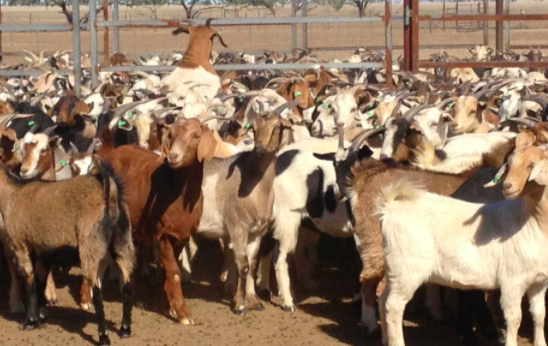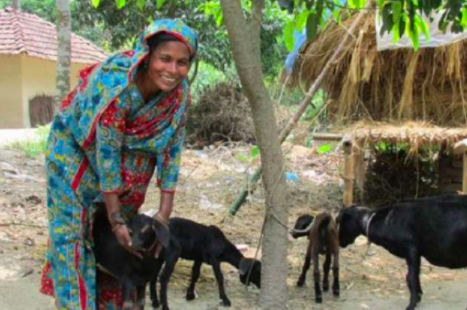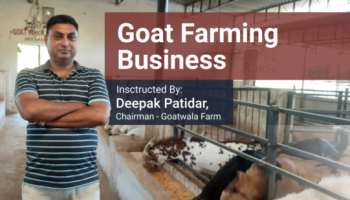Due to their relative inexpensiveness (as compared to cattle), goats are often referred to as the “Poor Man’s Cow”. Aside from milk, skin, hair and meat, which happen to be the most relevant reasons behind rearing goats in India, goats are also an important component of small, independent farms in arid regions of the country where cows and buffalos would fail to thrive. Much of rural India is already involved in the business of goat rearing at some scale or the other as goats are low maintenance. They survive on a wild shrub that grows even in dry regions devoid of much water.
The practice of systematically rearing goats with the objective of commercially exploiting the goat produced milk, meat, hair or skin or using goat as farm animals is what is commonly known as goat farming; and with regard to goat milk, it is said to be one of the least allergies causing milks as obtained from any animal and known to man. To draw contrast, about 70% of people are allergic to cow milk in some form or another – common allergic reactions include gas, stomach ache, rashes or in extreme cases, infection in the ear.
Goat Farming has been done in India since times immemorial and that is testament to the fact that there always was and there always will be a market for goat farming in India. Further, goats as said to be some of the first animals to ever have been domesticated, which indicates towards the ease of goat farming as a business, given how easy to maintain and domesticate goats are.
Some common goat varieties found in the southern region of the country include Malabari/ Tellichery, Attappady, Sannen x Malabari cross-breeds etc. In order to choose the right goats for your farm,you should definitely check for milk production. As an indicative yardstick, milk yield per day assessed by recording two consecutive milking for an adult goat, should be more than 0.5 kg. This will include the milk that is sucked by kids. When it comes to making a decision with regard to the young goats, the dam’s production can be used as a yardstick to measure quality.
Other indicators include body weight- for instance, one year old she-goat usually weighs around 20 kg while a 6-month-old would be anywhere above 10 kg. The youngling must not show any signs of ailment of deformity either.
Advantages of Goat Farming
The first and foremost selling point for venturing into a goat farming business is the fact that initial investment needed for Goat farming is pretty low. This is because besides coming in at affordable price, the cost of maintenance is also pretty low largely due to petite size and naturally calm demeanour. This also makes the housing and shedding requirements manageable and problems around taming goats are relatively pretty less.
Further, goats attain sexual maturity at the age of merely 10-12 months. This means more and more breeding and given how short the gestation period for goats is, they start milking pretty soon too, i.e. usually around the age of merely 16 or 17 months. Further, it is a frequent feature for goats to birth twins, therefore, multiplication doesn’t really take too long.

In draught regions or states with relatively low moisture, the possibility of successfully rearing goat is much higher than that of any other livestock species due to their constant need of quality feed as against goats, who can survive on shrubs that grow even in dry regions. Also, goats are pretty ideal for a setup of mixed species grazing.
Feeding on thorny bushes, weeds, crop residues, and agricultural by-products unsuitable for the consumption of cattle, they reduce conflict among livestock for feed and compliment most other livestock pretty well.
Talking about the quality of meat, which happens to be one of the most popular meats in India and the rest of the world, goat meat is more lean (low cholesterol) and a healthier choice for people who strive to take a low-calorie diet which is relatively easier for the body to digest (as compared to other red meat) especially in summer. Often, chevon (goat) is preferred over mutton (sheep) because of its chewy texture.
As we’ve mentioned already, goat milk is much easier to digest as compared to cow’s milk due to small fat globules and the fact that it is naturally homogenized. Goat milk also has a reputation for having the capacity to improve appetite and promote digestive health. Goat milk is relatively a non-allergic variety of milk and is prized for its anti-fungal and anti-bacterial properties. Goat milk is actively prescribed for treating urogenital diseases of fungal origin.
Talking about the cost of procuring and keeping, goats are 250% more economical than sheep on free range grazing under semi-arid conditions. They create employment opportunities for the rural people on farm and can be used for their many offerings as part of cottage industry, dairy utility and any other use of their hair or skin.
Setting-up Your Own Goat Farm
The whole process of setting up a goat farm can be condensed into seven simple steps. The same are following:
- Choose what breeds you’re interested to rear
Before you answer the question of “which bread?”, you must be clear about your reason for entering this business in the first place. Are you in it for the “meat”, the “milk”, the “hair” or just company of some domesticated animals? Your purpose will be the guiding factor for the choice of breed you make. Also, some breeds are needier as compared to the other with regard to the kind of feed or environment they require to survive in. Therefore, proper research must be conducted to figure out the ideal breed for yourself.
- Location Scouting
If you already have some area in mind or if you want to dedicate a certain part of your farm for this person, then you’re sorted at this end. If not, you’ll probably have to lease out some farm space if you wish to keep a sizeable number of goats for whatever purpose with some shaded area as well.
As with any livestock, it is necessary that such area is cleaned regularly to avoid any foul smell or spread of disease. There must be ample water and food available and the location ideally should not be surrounded by chaos. Chaos can induce anxiety among animals, and is definitely not recommended for their health and wellbeing.
- Constructing Shed
A sufficient space for goats of different ages and different demeanours must be created so that conflict can be minimized and complimentary goats can be nestled together. While goats per se don’t require a very spacious environment to live in, it is ideal to give them enough space to grow and hence, the shed should not be overly crowded.
The shed should have separate areas ideally for male, female, kids, breeding and feed. Beyond this, more demarcation can be done as per budget and need.
- Fencing
Goats go where the bush is – so to say, goats like to move around and forage. They’re not very good at staying put and like to wander. Further, goats can be easy targets for meat eating animals and hence, need to be protected from the voracious kind. Therefore, their movement should definitely not be restricted to the extent of making them uncomfortable, but be restricted towards keeping them safe and well within the broader boundaries of the farm.

- Feed and Water Arrangement
Either there need to be sufficient wild plants for goats to graze on, but in case of unavailability of the same, and to ensure quality milk or meat or even general health, nutritious feed and ample water must be provided to the goats at sequential intervals. The feeding well should be places at a certain height, about 1 foot or more upwards from the ground for the right posture and ease of feeding for the goats.
Similarly, water source should not be such that there’s standing water in the feeding well for too long. It could become a breeding ground for diseases if kept sedentary for too long. Corn, barley, sunflower seeds and hay make food feed for goat, rich in nutrients and fiber.
- Monitoring Behaviour and Temperament
While docile in isolation, goats in big herds have a tendency to be hostile and aggressive. This happens when the shed is mismanaged and there’s constant tussle between goats, given their sociability (often serving to be a cause of aggression, if they don’t get along too well). Much like gods, they love human company, so intervention may be useful to keep goats’ temperaments in check and under control.
- Understanding and facilitating breeding and feeding of the kid
Given how early goats mature, herd management demands the right amount and right frequency of breeding such that the same is manageable for the farmer. Also, once the goat begins to milk, it is necessary for the sustenance of the farm that the kid gets its share of milk before the same is collected by humans for commercial exploitation. Additionally, routine veterinary visits must be inculcated within the farm routine to maintain general wellbeing of all livestock, even beyond breeding and feeding.
While doing this on a large scale may feel cumbersome to a newcomer, it is common sentiment across farmers that goat farming is one of the easiest livestock farming options they’ve ever taken up. Besides being commercially rewarding, goat rearing is said to be cathartic in its own way, given how friendly and sociable goats are. Every form of farming comes with its own set of risks and difficulties, which must be accounted for but should not end up serving as intimidation driving you away from diving into goat farming. Hope this guide helped you in getting closer to your goal!
You can learn more about Goat Farming through the goat farming course curated by Mr. Deepak Patidar, CEO of Goatwala farms & Rocket Skills Expert.


